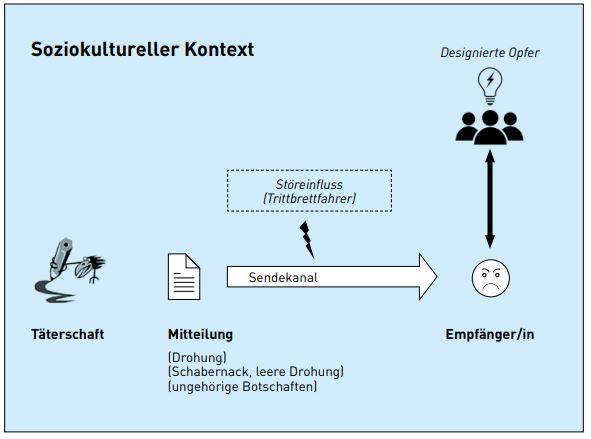De-escalation in the event of verbal slips and threats
The communication model shows what to look for when capturing verbal abuse. There are more elements than you think, and you should have them all in mind.

Knowledge of the environment is not found in any textbook, but is acquired solely through on-site work experience (e.g., in the hospital, at major events, at the train station ...). Accordingly, new employees must be carefully trained and familiarized with the most common scenarios.
Secondly, one must be aware that a great deal of "negative" but nevertheless important information is deposited with those employees to whom access is easiest (even if they do not have much power). The contact person of the threat or insult is often not the target person. Of course, all employees must be aware of this and enjoy continuing education so that they can pass on security-related information. In terms of safety, there is no hierarchy - all colleagues are very important and bear a great responsibility (e.g. also and especially the cleaning team). Threateners often turn to the reception or the secretary's office to intimidate managers. Threatening letters including their envelope (forensic evidence) must be kept in case of escalation. Anyone who discovers a threatening letter or blackmail should immediately put on gloves and put each sheet in a viewing folder, then photocopy them and forward everything to security. If threats are made over the phone, one should put it on speaker phone so that other employees in the office can listen in as witnesses. After that, you should write everything down as a memo as verbatim as possible and put it in quotation marks so that it is legally nailed down. This can be a handwritten note, it just has to be legible and comply with the form (place, date, time, signature). For example: The customer K., known to us, complained about the salesman V., that he had lied to her. She said at 10:30 a.m. today, 20.7.2022, at checkout 3: "Dä huere Siech chunnt dra." Signature Z., cashier morning shift.

Third, the channel of transmission must be taken into account. As a basic rule, the further away the perpetrator is physically, the less immediate danger he or she poses. However, this is only true for the moment. Anonymous messages on social media are written by people who are too cowardly to stand by their criticism. It becomes more threatening when a perpetrator privately scouts out the target and shows up at his or her home.
Next, the nature of the inappropriate communication must be considered. Name-calling and insults serve to blow off steam and rebuild a damaged self-esteem of the perpetrator. They are not the same as threats. Emotions in the case of complaints are also not necessarily already an assault; it always depends on the exact circumstances.
Interventions to calm the situation and gather information
Every intervention has two functions: It should always de-escalate and it should - if possible - gather information.
In the case of disgruntled customers, for example, more information is needed. The displeasure may be justified, and the company would be doing itself a disservice if it were to turn away those affected. You can ask about this: "When did this upset start? What happened?" The when question is more purposeful than the why question because it refers to concrete events and perceptions. The "why" tempts further ranting because it also includes vague assumptions by the clientele. Haden Elgin's recommended book covers several forms of verbal abuse and how to respond (pp. 102-118).
If people are emotionally agitated, they should under no circumstances be met with "Please, calm down" or "Let's stay objective". These phrases come across as arrogant and fuel the conflict (Haas 2014). Between the lines, they imply that the customer is wrongly emotional, while the professional is above it and objective. Put simply: "I'm the boss here and you're crazy," no one wants to be treated like that.
A good response is worded in a way that is open to the possibility that the ranting clientele may have a legitimate concern. For example, the correct answer is: "I can see you're upset about the mask requirement." Other answers that keep the ball rolling are: "A lot of people think like you, but we still can't ..." After the explanations of the clientele, you can continue with: "I see your anger, I might not feel any different if I were in your shoes, but try to understand us too, we are only human." If someone is about to explode, you can bring them down by praising their self-control (as long as no objects have flown yet): "I notice that you are making a great effort to control yourself despite the very uncomfortable situation, and I appreciate that very much."
Finally, a temporary solution must be sought - depending on the justification of the concern. If it is justified, but you do not have time, you should choose a positive formulation so that the person does not feel devalued: "We take your concerns very seriously, so you'll get an appointment with customer service next week where they can describe it in more detail." In the case of problems that would be justified in a general sense (or theoretically could be) but cannot be solved by the company in charge, a two-part answer is good. "Yes, your concern is understandable socially (or in your situation, as the case may be), but we don't have the ability to implement it here now. Businesses have a lot less power than people think." In the case of persistent insistence on unrealistic requests, one should not hesitate to call the appropriate contacts with understanding, e.g.: "You'll actually have to contact the political party of your choice on that one, we can't change the law with the best will in the world", or with mental patients who come up with bizarre ideas: "This is beyond my expertise, and it goes more into the health area, I think you should discuss this with your primary care physician."
In the case of verbal threats, it is advisable to calmly ask for as much further information as possible. For example: "Mhüh ...?", and questioning facial expression or: "I didn't quite understand that now ...", or, "What are you trying to tell me?", or: "What do you have in mind when you say 'next time it will be knocking here'?" Of course, evasive answers then often come, but these also allow conclusions to be drawn, for example, whether the future is vague or whether physical violence is really imminent (more on this in Haas 2004 and 2009).

Of course, one does not have to let insults and discrimination go unchallenged or leave the victims out in the cold. There are appropriate responses that keep the ball rolling. Symbolically, they are like aikido, you take a step to the side and let the attack go nowhere, e.g.: "It is the case that many people think women are not very competent, but I am surprised that you think so." (Or, "But I don't share that view.") With boys, a pinch of self-irony sometimes helps. As a therapist in prison, I myself have already replied to such things: "That's right, we women also have smaller brains ...". Then, as a rule, a smile sets in and a certain self-reflection is set in motion. Racist attacks are currently a big topic. What do you do if you are affected? Again, there are several options. On the one hand, one can cultivate a self-confident approach to devalued terms so that they lose their old meaning and become positive. For example, the former swear word "gay" has been disempowered. On the other hand, historical examples can be cited, for example, people of color have been in Switzerland since the Stone Age - i.e., "pure whites" do not exist here. This is proven by the skeleton of an approx. 30 year old woman, which was found in Egolzwil LU in 1901, but could only later be anthropologically assigned with the skull masses (1924) - it resembles African and Melanesian skulls. At that time its age was estimated to be about 6000 years, but it has never been examined with modern methods. Under the influence of the Nazi era, it was internationally hushed up at the anthropological congress in London from 1934 on, and the local historical science has not bothered to change that until today (Haas 2020). When asked the intrusive question "Where do you actually come from?" or the N-word, one may sit back and refer to the prehistory of Switzerland. A "white race" with more "homeland claim" there is not here. Scientifically, there are no "races" at all (Jena Declaration), there are only external characteristics.
Life attitude and moral courage
These were some suggestions for practice, but not every sample set is equally suitable for all situations. Which intervention is ultimately adequate and specifically helpful must be decided by each person based on his or her intuition at the moment. Incidentally, it is helpful for one's own psychological well-being if one does not write off such episodes as a "disorder" or even as a "trauma," but rather as a sporting challenge. They are opportunities to acquire even more social competence. One learns it better and better and gains more and more calm and competent civil courage. Later, by the way, the unpleasant becomes an adventure, a life experience, or you can even laugh at the stories. The contrast makes life exciting and lets you really enjoy the relaxed and beautiful moments.
Further reading
- De Becker, G. (2017). Trust your fear: How our intuition protects us from violence. Munich: mvg Verlag.
- Haas, H. (2014). The animal in me. Dealing with situations of violence and threat from a neuro-psychological perspective. Kriminalistik, 68(1), 47-53 (www.zora.uzh.ch/id/eprint/91010)
- Haas, H. (2009). Progress analyses of domestic violence. In: Federal Ministry of Justice (ed.), Lebensform Familie - Realität & Rechtsordnung. Austrian Judges' Week Laa an der Thaya, May 26-30, 2008. FOJ publication series, Vol. 141: 121 (www.zora.uzh.ch/id/eprint/24915)
- Haas, H. (2004). Dangerousness assessment of threats. Kriminalistik, 58(12), 791-799 (www.zora.uzh.ch/id/eprint/97196)
- Haden Elgin, S. (2000). The Gentle Art of Verbal Self-Defense at Work. New York: Prentice Hall Press.
- Jena Declaration (2019). The concept of race is the result of racism, not its precondition. (available free of charge at: bit.ly/3dcu4Ih)
Other sources
- Editor (Oct. 1934) Man. Journal of the Royal Anthropological Institute of Great Britain and Ireland (bit.ly/3QBLXxR)
- Haas, H. (2020). Is there a skeleton in the closet of the Julius Klaus Foundation? Jahrbuch der Schweizerischen Gesellschaft für Familienforschung, 47: 221-264. (free download: bit.ly/3BxIVGN).
- Koller, R. (1935). Plastic reconstruction of the physiognomy of prehistoric humans. Anthropos 30(5/6), 857-858.
- Neue Zürcher Zeitung, 14.8.1934, about the anthropologists' congress in London in August 1934.
- Schlaginhaufen, O. (1924). "The results of investigations on anthropological material from Lake Wauwil". Mitteilungen der Naturforschenden Gesellschaft Luzern, Vol. 9 (bit.ly/3L41jdu)
- Schlaginhaufen, O. (1925). The human skeletal remains from the Stone Age of Lake Wauwil (Lucerne) and their position in relation to other anthropological finds from the Stone Age. Erlenbach-Zurich, Munich and Leipzig, E. Rentsch.









